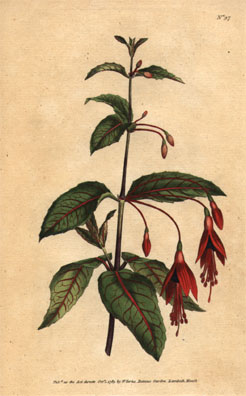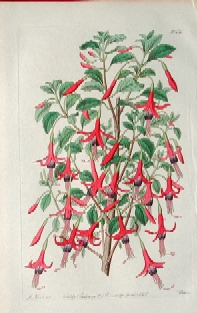18-I.
From the history of the fuchsias - Part I |
 Go to Dutch version
Go to Dutch version
Recently I found during removing my archives with all
sorts of fuchsia information, a number of copies from an articles-series
out of the gardenmagazine 'Onze tuinen'
(Our gardens) from
1925. These articles form together a very good detailed
synopsis of the history of the fuchsia in the period 1696-1866. Much of
the presented information in it, I hadn't still read before in a book or
on a website of internet, In the articles
were not placed pictures, but in it stood
many references to antique botanical volumes,in which was to be find an
engraving print of a described fuchsia. But that antique
volumes are very scarce and expensive, and they
are'nt or hardly not to consult in university libraries etc..
But from many references to the prints, I have meanwhile
assembled via internet digital pictures, Therefore it became now
possible the copied text to present
here on internet illustrated. The text in the gardenmagazine is drawn up in
an 'old Dutch language ' and was standing full of germanism
because of the
translation from out the German language..Correct translating in English was here sometimes
difficult, I ask you pardon for this. Think by
reading the following
information and that in the following parts, you interprets this as if it is
now the year 1925!! |
.
| The
plant
'Fuchsia'
with the nice red 'bells'' hanging between the
oval green leaves, know hardly everyone. Special in former days this
South-American plant was grown in all sorts of varieties, as pot-plants
for borders or as balcony- and windows ornaments. |
|
The most
grateful form of the fuchsia as culture plant is well the standard with
less or more horizontal spread stems. There is a large variety in
flowers of the different varieties. |
|
The rise and the period of glory of the fuchsia is now far behind us and is
to find in the century before. when new
varieties (species) were imported again and again and the
nurserymen did their utmost to make new cultivars from out seed. And
there was then earned much money in cultivating these plants till at
least they had become as popular as the Geranium (Pelargonium).
But that means not, that the fuchsia now had
disappeared outof cultures. It is a very
believed plant for 'Floralia-societies' and some nurserymen - special in
La France and Germany - maintain still always nice
collections of different fuchsiavarieties,
while in antique gardens and on country seats are to find often still
beautiful standards. |
|
 |
|
Charles Plumier |
|
The
Franciskaner monk Charles Plumier -
so we read there - (born
following Wildenow in 1646,
but
following
Sprengel
in 1666 in Marseille),
discovered in 1696, on
his second voyage in America, done
in order of Louis XIV, a graceful shrub,
that he for honour of the famous botanist Leonard Fuchs,
named'Fuchsia'
and that he discribed as'Fuchsia
triphylla flore coccineo' in 'Nova
plantarum Americanarum genera, Parisiuis, 1703'.
Linnaeus maintained the name
'Fuchsia'
and devided the plants by that under the 8e
class
1e order of his
system (Octandria Monogynia). In
the series of the natural families the
fuchsias belong to the Onagrariaceeën or Oenotheraceeën. |
|
It last more than a century before
there was added to the only known fuchsia other ones. First
in 1820 came in this a transformation
by new voyages of discovery to the west of America, and
since that time one can say, that the number of species of
the genus named above, steady and not in low mate has grown. |
|
|
From nature fuchsias are growing in moist shadowed spots
in woods, or also on soft sloping slopes and they are numerous in Mexico, Peru, Columbia
and Chili.
Some species were found in New-Sealand. |
|
In 1825 De Candolle
make allready mention in his
'Prodomus'
of 26, and Dietrich
in 1841 in his
'Synopsis'
of 34
fuchsia species. In 1848 this
number has allready rised till 40 present day
( Red.: then it was anno 1866! )
you may suppose, that there are allready between 40
and 50. However we had to add
that not all these species you can find in our gardens. The first import
of a fuchsia in Europe dates from 1788.
Accidental this was also the first discovered fuchsia of
Plumier, that was
destined for that import. |
|
F.coccinea
Ait. [Bot.Cab.
plate 933 and Curtis's Bot. Cab.
plate 97, see afb.1],
which is described by Plumier
as
Fuchsia triphylla flore coccineo
which has been
discovered first of all varieties, has scarlet sepals and a purple-blue crown. At
the end of the 18e
and begin 19e century
it was exposed many times as ornament in
greenhouses. Short after its
import you meet this plant in Germany in the court garden in Stuttgart,
and by the merchant Bremer in Tillit.
By last named it flowered in 1796.
One treated it with much care and
even so that in 1810 a plantlover complained
himself public that two specimens of his fuchsias
had died, while he on advice of some writers he let them
standing in the open air. F.coccinea
was remained long time the only caressed
of her race, such as among other
things we can conclude on the fact that people in the edition
from 1832 of
'Wrelow's Garten-freund',
no other one was placed at her side than
only
F.gracilis.
You find
F.coccinea
till now adays in many gardens
Still recently was cultivated of it a
cultivar with the name'Coccinea superba'.
|
|
 |
|
Pict..1
F.coccinea - plate 97 in 'Curtis's Bot. Mag.' |
|
|
|
F.lycioides
Andr.
came to us in 1796 from Chili
and the Northwest coast of America.
She had bright red sepals and a redpurple crown. Andrews
pictured her in his Bot. Register on plate
120 [see pict.2a]
and
Curtis in his
Bot. Mag. on
plate 1024 [see
pict.2b]. |
| F.excorticata L.
was afterthat following Porcher
imported fom New-Sealand to England in 1821
This one is pictured in Bot. Reg.
plate 857, in Otto's Abbild on plaat 46 en
in het Bot. Cabinet on plate 1347.
People find her wel nice but tender.
Her sepals changes from green in blue and at last in
red; her crown is darkpurple. |
|
|
|
|
Pict.2a F.lycioides
- Plate 120 in 'Bot. Reg.' |
|
Pict..2b
F.lycioides - Plate 1024 in 'Curtis's Bot. Mag.' |
|
Pict.3
F.arborescens - Plate 2620 in 'Curtis's Bot. Mag.' |
|
Pict.4
F.arborescens - Plate 943 in 'Bot. Reg.' |
|
|
|
.
In
'Reiders Annales'
you find a picture of
F.arborescens
Sims
[Curtis Bot. Mag. plate 2620,
see pict.3; Bot. Reg.
plate 943, see
pict.4], and to that
also the note, that this species
since 1824 as ornamental plant is
taken in culture. From her earlier rarity
testifies, that she in 1830 on a exposition of flowers in Vienna was
endowed with an award. Lateron Hartweg
found in Oazaca, along
the shady bords of a brook, a
specimen of
F.arborescens
of 12 feet high and with a trunk
of 2 inch diameter. |
|
Some
authors consider
F.syringaeflora
[Flore des
Serres, plate 416-417] as a
cultivar of
F.arborescens,
however against this opinion are objections, namely
: 1e. this one isn't coming from Mexico, 2e.
she flowers with plumes, what this one isn't doing..
For the rest
F.syringaeflora
is only
important for the nurseryman because of the fact when planted in autumn
she gives in winter flowers. |
| . |
|
 |
|
Pict..5
F.gracilis - Plate 847 in 'Bot.
Reg.' |
|
Pict..6
'Multiflora' - Plate 1514 in 'Bot. Cabinet.' |
|
In 1825
became, following Porcher,
iF.gracilis Lindl. [Bot. Reg.
plate 847, see
pict.5,
the Bot. Cab..
plate 934 and
the Curtis's
Bot. Mag. plate 2507]
imported from Chili
and Mexico in the European
gardens. With respect to the colour of its flowers not
unequality to
F.coccinea,
distinguished nevertheless this one by her
more slender and more gracefull stems,
Don
held this variety for a cultivar of
F.
macrostemma.
A multiflowering cultivar of
F.gracilis
is
'Multiflora',
you find this one in the
Bot. Reg. plate 1052
and the Bot.
Cabinet plate 1514,
see pict.6].
The
import from Mexico in Europe of
F. microphylla H.B. [Bot.Cabinet. plate
1545, see pict.7
] dates following Porcher
from |
|
Pict.7
F.microphylla - Plate 1545 in Bot. Cabinet |
|
Pict.8
F.globosa- Plate 3364 in 'Curtis's Bot. Mag.'. |
|
1827.
Lastnamed species has purple sepals and a
dark purple crown, and belongs with
F.cylindracea,
till the best species with
little flowers, sothat she then even now
adays in nurseries of name still becomes propagated.
A cultivar from
F.microphylla
with larger flowers is known by nutserymen under the
name
'Grandiflora'.
F.linoides,
in 1830 pictured by
Reider, wasn't
nice enough to maintain itself as ornamental plant,
The turned was on the other hand the matter
with
F.globosa
Lindl.,
that achieved a great succes, while it is more hard and more solid
from nature as ornamental plant for the livingroom. |
|
|
Successively this variety was pictured in the Bot. Reg. plate
1556, the
Bot.Cabinet. plate
1981, and the Curtis's Bot. Mag. plate
3364 [see pict.8].
Of nature
F.globosa
is low;
on the other hand however it has the property of
mild flowering . Its flowers have scarlet
sepals and a brown-purple crown. By crossings between F.coccinea
and
F.globosa
they got several cultivars ,which in that time
all were very beloved. With regard to the
origin of
F.globosa
people
isn't sure;
so even some authors go so far to consider it as a
cultivar of
F.macrostema.Among
the most important cultivars of
F.globosa
belong the varieties
'Erecta'
with upstanding flowers and the variety'Maxima'
with larger and more nice flowers; also some other
cultivars, that in 1852 were brought into
commerce by Meillez. |
|
, |
|
Still a better receipt than to
F.globosa
fall to its lot to
F.fulgens
Lindl. [see
pict.9]
this wasn't wondering because of the large red lead
flowers. |
|
F.fulgens
was discovered in Mexico by two Spanish
naturalists -
Mocino and
Seffe
- however first in 1837
brought to England by
Hartweg . She first flowered by the
nurseryman
Lee in Hammersmith,
and procured him the argent medal of the Horticultural Society.A
year lateron Audot exposed
her on a meeting of the he Société Royale d'Horticole
in
Paris and there they made much sensation,
By crossings between
F.fulgens
with
F.globosa conica
and
F.gracilis
the long range of cultivars has become, that
still always become remained till nowaday. Till in 1841
concerned
F.fulgens
as the nicest under all known species and in that time one of
her varieties-
F.dependens Hook -
was sold for 3 mark
in Flottbeck and for
10 franc in Liége.
The ripe berries of
F.fulgens
are fit to eat
and smell after apples. |
|
Pict
.9 F.fulgens- Plate
107 in 'Favorite Flowers of Garden and greenhouse'
from Edward Step |
|
|
At the
same time with
F.fulgens,
many
other varieties were brought into commerce; because
the origine of them wasn't allways to indicate sure. Without doubt
they must have been considered as hybrids (cultivars). Till
that section belongs among others
'Mutabilis'
of the
English florists, since 1836 known by the
nurserymen and also
'Thomsonii'
and
'Youngii grandiflora'.
People beleave free general that
'Mutabilis'
is descended from
'Macrostemma',
and
'Thomsonii'
from'Macrostemma'x
F.gracilis.
'Mutabilis'
has scarlet sepals and in the beginning, a blue,
however lateron a blueviolet corolla. |
|
((Will
been continued in part II) |
|
|
|
. |
. |
|
|
''Gelderse Fuchsia Info-site'-
 November 2008
November 2008 |